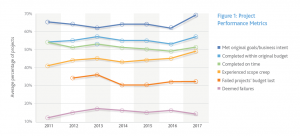About project management
In the last 10 years, companies are evolving in a very competitive environment with important challenges due to the digital imperatives and regulatory steady changes. They are launching strategic initiatives to transform both their business and operating models to be able to bring appropriate responses to face new competitors, to be more clients focused and to manage the regulatory risks.
Projects and programs are key levers of this transformation – they make change happens. Successful project management is becoming key for organisations with direct impacts on the bottom line: (1) contribute to gain new clients, (2) improve efficiency of the operations and (3) decrease risks provisions and (4) avoid fines (this article provide an interesting view on the paid fines last years).
Project management maturity is progressing within organisations, the last PMI survey (PMI 2017 survey) reported a positive trend of project management performance metrics (figure 1): “For the first time in five years, more projects are meeting original goals and business intent and being completed within budget”. But there is still a room for improvement in areas such as “completion on time” or “scope creep”.

At NovInsight, based on more than 20 years of proven experience in project management within wide range successful programs, we designed our methodology to master projects and programs delivery. The methodology is articulated around six key indicators that should be designed, implemented and maintained during all the project journey, they allow to steer:
1 – Requirements: specify clearly the scope, manage tightly the changes, and ensure the requirements are in line with the organisation stakes. Overall, it ensures requirements are realistic and achievable through real partnership between the customer /user and the project team.
2 – Clients Expectations: ensure the project /program will provide effective added value for users / clients; anticipate users / clients and executives’ expectations; assess users’ satisfaction on a regular basis
3 – People and skills: put the right people at the right place, assess the staff satisfaction on a regular basis, and ensure project team keeps the appropriate level skills for the project including, technical, leadership and business capabilities
4 – Strong governance: ensure effective sponsorship with appropriate decision power, ensure users’ representatives are involved in the decision-making process including active participation of key users and sponsor in the steering committees
5 – Roadmap: a specific attention should be paid to “tunnel effect” in the projects/programs timeline: the momentum with users should be maintained through regular and close deliveries
6 – Budget: tight follow up is required as it is a central lever to facilitate the requirements and roadmap changes as well as executive communication
These key indicators should be considered at different stages of the project lifecycle: (a) at the framing phase it will allow to identify the issues and design appropriate solutions, (b) during all the project journey to forecast the behaviour of the project and envisage mitigating actions when required.







